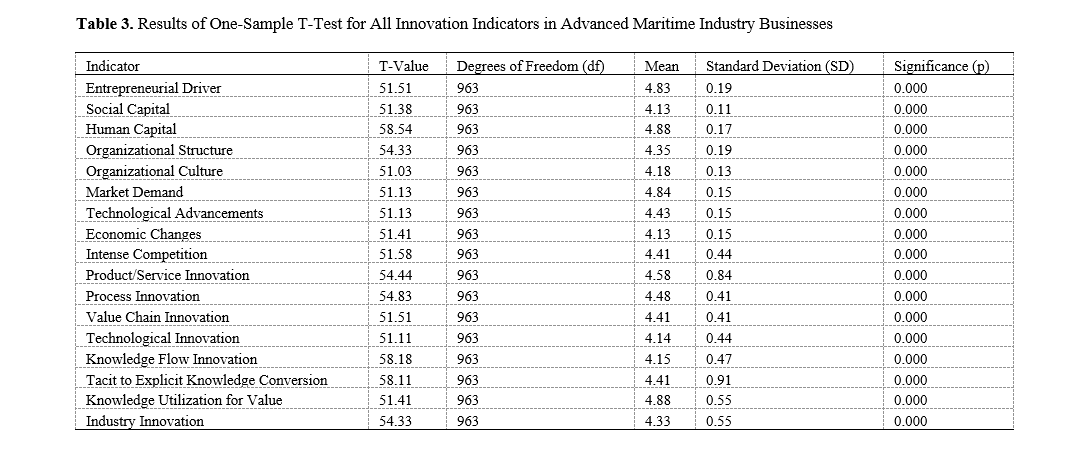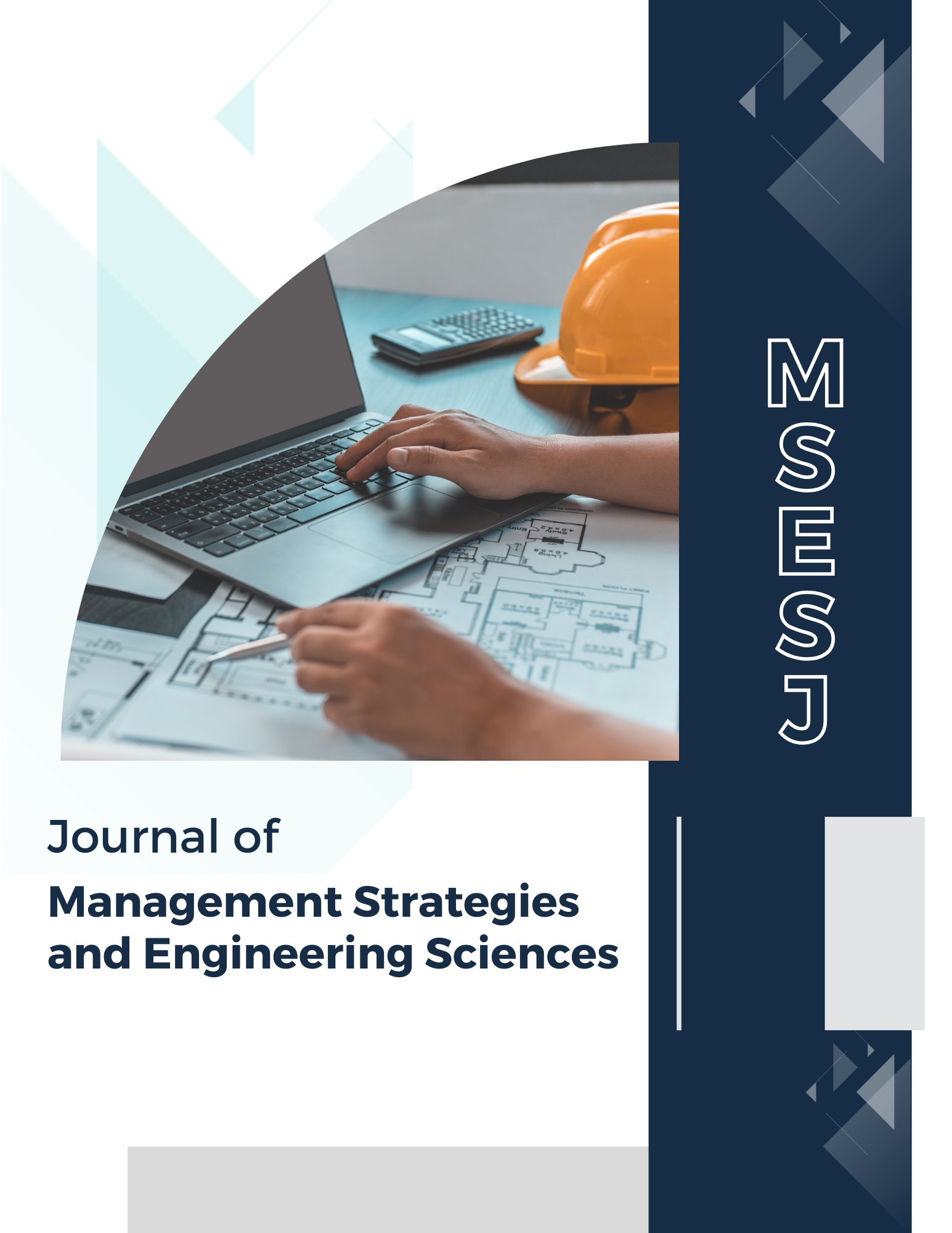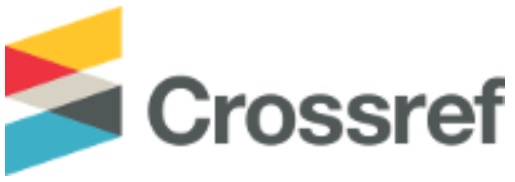The Role of Innovation in the Performance of Maritime Services Using Unmanned Vessel Technologies
Keywords:
Innovation, Maritime Service Performance, Technology, Unmanned Vessels, HormozganAbstract
This study aims to investigate the role of innovation in improving the performance and competitiveness of small shipbuilding businesses and advanced maritime industry businesses in Hormozgan Province. The study employed a descriptive-survey research design, with data collected through structured questionnaires distributed to employees and experts in small shipbuilding businesses and advanced maritime industry businesses. The total sample size comprised 950 respondents. Statistical analyses, including one-sample T-tests and Pearson correlation tests, were performed using SPSS to evaluate the impact of various innovation indicators, such as entrepreneurial drivers, human capital, and technological advancements, on business performance and competitive advantage. The results showed that all innovation indicators had significantly higher mean scores than the neutral benchmark of 3 (p < 0.001), indicating their positive impact on performance. Key factors for small shipbuilding businesses included entrepreneurial drivers (mean = 4.43), human capital (mean = 4.95), and technological advancements (mean = 4.61). For advanced maritime industry businesses, human capital (mean = 4.88) and knowledge utilization (mean = 4.88) were critical contributors. Overall innovation performance scores were 4.14 for small shipbuilding businesses and 4.31 for advanced maritime industry businesses, highlighting the substantial role of innovation in both sectors. Innovation serves as a fundamental driver of performance and competitiveness in maritime businesses. Emphasizing human capital development, leveraging digital technologies, and fostering a culture of innovation are essential for sustainable growth. However, challenges such as limited collaboration and knowledge-sharing mechanisms need to be addressed to maximize innovation's potential impact.
References
N. Wu, "Experimental Study on Autonomous Docking and Hook-Locking Control for Unmanned Surface Vehicle Platforms," Proceedings of the Institution of Mechanical Engineers Part I Journal of Systems and Control Engineering, vol. 238, no. 3, pp. 448-464, 2023, doi: 10.1177/09596518231198186.
J. Powell, "Future of Shipping," 2019, doi: 10.24868/icmet.oman.2019.029.
Q. Kong, "Autonomous Vessel Design for Efficient Marine Debris Collection: A MATLAB Simulink and Arduino-Based Approach," Te, vol. 1, no. 5, 2024, doi: 10.61173/qcxhmx26.
A. Lazarowska and A. Zak, "A Concept of Autonomous Multi-Agent Navigation System for Unmanned Surface Vessels," Electronics, vol. 11, no. 18, p. 2853, 2022, doi: 10.3390/electronics11182853.
Z. Piao, C. Guo, and S. Sun, "Adaptive Backstepping Sliding Mode Dynamic Positioning System for Pod Driven Unmanned Surface Vessel Based on Cerebellar Model Articulation Controller," Ieee Access, vol. 8, pp. 48314-48324, 2020, doi: 10.1109/access.2020.2979234.
S. Xing, H. Xie, and W. Zhang, "A Method for Unmanned Vessel Autonomous Collision Avoidance Based on Model Predictive Control," Systems Science & Control Engineering, vol. 10, no. 1, pp. 255-263, 2021, doi: 10.1080/21642583.2021.1986752.
L. Maleš, D. Sumić, and M. Rosić, "Applications of Multi-Agent Systems in Unmanned Surface Vessels," Electronics, vol. 11, no. 19, p. 3182, 2022, doi: 10.3390/electronics11193182.
G. B. Chistyakov and O. E. Ol'khovik, "Tasks of Developing the Aquatory for Testing Autonomus Ships in Inland Waterways," E3s Web of Conferences, vol. 157, p. 02010, 2020, doi: 10.1051/e3sconf/202015702010.
O. E. Ol'khovik and A. Butsanets, "Structure and the Basic Operating Principles of Test Water Zone for the Testing of Unmanned and Self-Piloted Vessels," Iop Conference Series Earth and Environmental Science, vol. 988, no. 4, p. 042053, 2022, doi: 10.1088/1755-1315/988/4/042053.
J. B. Høstmark, "Proposed Method for Analysis of Eye Tracking Data From Unmanned Ship Operation," pp. 2830-2837, 2023, doi: 10.3850/978-981-18-8071-1_p200-cd.
M. A. Elhafez, "Utilizing of the Quality Function Deployment (QFD) to Analyze the Effects of Using Autonomous Vessels on Maritime Shipping Factors," Maritime Research and Technology, vol. 2, no. 2, p. 151, 2023, doi: 10.21622/mrt.2023.02.2.151.
Q. Wang, S. Liu, B. Zhang, and C. Zhang, "FBLS-Based Fusion Method for Unmanned Surface Vessel Positioning Considering Denoising Algorithm," Journal of Marine Science and Engineering, vol. 10, no. 7, p. 905, 2022, doi: 10.3390/jmse10070905.
M. Kadyrov et al., "Design and Construction of the Cadet-M Unmanned Marine Platform Using Alternative Energy," E3s Web of Conferences, vol. 140, p. 02011, 2019, doi: 10.1051/e3sconf/201914002011.
K. Zwolak, R. Miętkiewicz, J. Dąbrowska, and N. Tinmouth, "The Assessment of Unmanned Vessel Operation in Heavy Traffic Areas. Case Study of the North Sea Crossing by Unmanned Surface Vessel Sea-Kit," Maritime Technical Journal, vol. 224, no. 1, pp. 41-67, 2022, doi: 10.2478/sjpna-2022-0004.
J. B. Krawczyk, "The Era of the Unmanned Vevicles Is Coming," Przegląd Nauk O Obronności, no. 11, pp. 27-42, 2021, doi: 10.37055/pno/142494.
S. V. Smolentsev and A. Sazonov, "Monitoring of the Process of Safe Divergence on the Part of an Unmanned Vessel," E3s Web of Conferences, vol. 244, p. 08012, 2021, doi: 10.1051/e3sconf/202124408012.
Q. Wu, T. Wang, M. A. Diaconeasa, A. Mosleh, and Y. Wang, "A Comparative Assessment of Collision Risk of Manned and Unmanned Vessels," Journal of Marine Science and Engineering, vol. 8, no. 11, p. 852, 2020, doi: 10.3390/jmse8110852.
K. Obaideen, "Autonomous Unmanned Systems: Traversing the Bibliometric Terrain of Genetic Algorithm-Based Path Planning," p. 8, 2024, doi: 10.1117/12.3013834.
T. Ishikawa, Y. Yokota, S.-i. Watanabe, and Y. Nakamura, "History of on-Board Equipment Improvement for GNSS-A Observation With Focus on Observation Frequency," Frontiers in Earth Science, vol. 8, 2020, doi: 10.3389/feart.2020.00150.
J. Wilkins, "Improving Spatial and Temporal Monitoring of Dredging Operations Incorporating Unmanned Technologies," 2023, doi: 10.21079/11681/47520.












